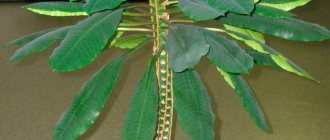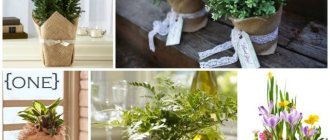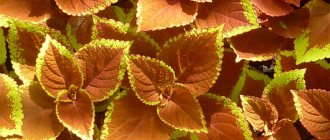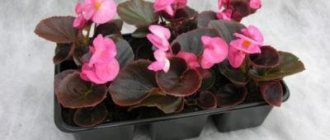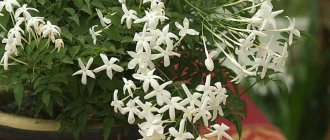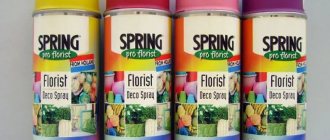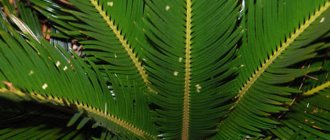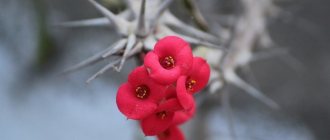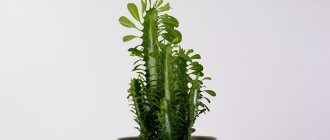Since white-veined milkweed (Euphorbia Leuconeura) is a subtropical plant, breeding and subsequent care for it at home requires compliance with the appropriate rules.
It is distributed in America (central and southern regions), on the island of Madagascar, Africa, the Canary Islands and Arabia. The most suitable climate for this succulent is hot and dry.
In order for the plant to take root in a city apartment, it must be placed in the most illuminated area . In homes where the air temperature can periodically drop to +10°C, this type of milkweed will not be able to develop and will most likely die.
Description
Latin name Euphorbia leuconeura.
This herbaceous perennial looks like both a cactus and a palm tree. It has a long fleshy stem with ribs and spines, which thickens somewhat towards the top.
The top of the trunk is crowned with a lush crown - a palm tree of elongated leaves. The plant reaches a height of 1-1.5 m (both in nature and at home). The leaves look very impressive - dark green, white-veiny, shiny.
Small flowers appear in spring and summer, but the flowering of this species is not decorative. The fruit of milkweed is a capsule. When ripe, it shoots seeds several meters, which is why they can end up in pots with other plants.
Inside the stem and leaves there is a poisonous juice that can cause burns on the skin and mucous membranes. When working on flower transplantation, pruning and cuttings, you need to wear gloves and goggles.
Transfer rules
It is not recommended to transplant too often. As long as the roots have not filled all the free space in the pot, the tree will develop perfectly without outside interference. Before replanting the monkey tree, you need to dry the soil a little. The procedure is planned for early spring. You should prepare a wide pot with holes in the bottom. First, pour out shards or brick chips.
The soil for planting should include the following components:
- sand;
- turf land;
- peat;
- leaf soil;
- charcoal.
It is important to be extremely careful with the rhizome and use the method of transferring the earthen clod. The old soil should be preserved as much as possible.
Purchase and adaptation
When purchasing, inspect the plant for foreign stains, damage, or softened areas of the trunk. The leaves of a healthy flower are green and shiny, with whitish veins, but without yellowness. The roots should not be dry and stick out from the drainage holes.
At first, the white spurge adapts to its new place of residence: it is better not to disturb it or replant it (in two to three weeks it can be replanted).
It is advisable to make this period a quarantine period - place the perennial away from other plants. Check your euphorbia regularly for signs of disease or pests. Provide her with comfortable maintenance: warmth, light and moderate watering.
The necessary conditions
Priming
Typically, White-leaved spurge is planted in a special substrate for succulents. You can prepare your own soil mixture from turf and leaf soil with the addition of coarse sand. Euphorbia is not demanding on fertility, but prefers slightly acidic soils.
Humidity
White-leafed spurge is undemanding to air humidity, but responds well to regular ventilation. It is important to avoid drafts. Once every few months, it is recommended to wash euphorbia under a lukewarm shower. When soiled, it is necessary to wipe the leaves from dust with damp cotton wool.
Temperature
The indoor flower loves warmth, tolerates temporary heat and drought, but is sensitive to cold. In summer it feels good at a temperature of 24-25°C, in winter – at 17-18°C. In the warm season, it is useful to take euphorbia to the balcony or loggia.
Illumination
To successfully grow milkweed you need good lighting. In the house it is better to place it on the south windows. In winter, artificial supplementary lighting is useful. In summer, it is advisable to place the indoor flower in the sun.
Growing rules
The culture does not make high demands on cultivation. However, the following conditions must be met:
- Temperature. In summer, the optimal temperature is considered to be +20-25 degrees. As it increases, the leaves begin to dry out. In winter, this value drops to +18 degrees.
- Humidity. Despite the fact that the plant feels good at room humidity, you should not place the pot near heating devices. This leads to overdrying of the soil. In spring, the crop is taken out onto the balcony for ventilation.
- The soil. For this purpose, ready-made soil is purchased and mixed with sand in a 2:1 ratio. To allow the soil to breathe, a hole is made at the bottom of the pot. The first layer is laid with fine gravel.
- Lighting. The best option in the summer is to take the pot out into the garden. In winter, you need to turn on the fluorescent lamp.
Do not install a powerful lamp - young shoots may be burned.
Home care
Caring for White-veined Euphorbia is not difficult, but successful maintenance involves several important rules. The flower needs good lighting, moderate watering and a comfortable temperature.
In winter, a period of rest begins, so euphorbia is watered less often and feeding is stopped.
Feeding
You need to fertilize milkweed once a month.
In summer and spring, spurge is fed monthly. The best fertilizing option would be complex fertilizers for succulents.
For enhanced growth and in case of insufficient lighting, gardeners recommend adding a weak solution of bird droppings to the soil.
Watering
Water the plant sparingly, using soft, settled water. It is important that by the next watering the top layer of soil dries well, but does not dry out completely. The frequency of the procedure is 1-2 times a week.
If there is a lack of moisture, the leaves of the flower turn yellow and droop; if there is too much moisture, they fall off. However, the latter case is more dangerous because it threatens to rot the roots.
Trimming
White-veined spurge can grow up to 1.5 m, which often makes it necessary to shorten it. Pruning is carried out after flowering with a sharp, disinfected knife (while wearing rubber gloves and goggles).
In addition, the procedure stimulates euphorbia to “bush”—throw out side branches from the trunk. Trimmed shoots can be dried and used for propagation.
The cut area on the plant is treated with crushed coal.
Transfer
Young milkweeds grow quite quickly, so they need replanting annually (if a larger container is required).
If the plant is not yet cramped in the pot, you can simply replace the top layer of soil with a new substrate for succulents.
It is recommended to replant adult euphorbia every 3-4 years.
Common Milkweed Ailments
In winter, milkweed often drops its leaves due to lack of sunlight, and if you water it abundantly during this period, you will soon be forced to “admire” an absolutely “bald” trunk. “Leaf fall” in this plant is a natural process and should not be confused with a disease; in the spring everything will return to normal.
If your flower has enough light, moisture, is not terrorized by insects, and the roots have enough space to develop, a little leaf fall should not scare you.
Euphorbia can shed its leaves when there is a lack of phosphorus. You can make up for the deficiency with a solution of double superphosphate, diluting a teaspoon of the substance in a liter of water. The plant should be watered with this mixture twice with a break of a week. Consumption is approximately half a glass per pot with a volume of 20 cm3.
Another reason why spurge may shed its leaves is when the soil in the pot dries out. Even in winter, watering cannot be stopped. One procedure approximately once every 2 weeks is sufficient.
Even a succulent can wilt from lack of moisture in the pot.
Rotting of the trunk is most often provoked by abundant watering in combination with low air temperatures. If you notice the disease in time, you can cure spurge by drying the earthen clod and moving the pot to a warmer place. A rotten trunk (if the root collar is intact) can be cut off, leaving the lower 2–3 cm, and the plant can be allowed to recover again.
Leaves wither and wrinkle when the plant does not have enough light. Bright lighting is the main condition for the development of milkweed. With its deficiency, leaves, especially young ones, may darken.
Dark or even black spots on greenery indicate the development of a fungal infection, which can be successfully treated with any fungicide for indoor flowers, for example, Alirin-B or Vitaros.
If the spots on the foliage are the result of sunburn, then they appear stronger and have a brown tint. It is enough to shade the plant or remove it from the southern windowsill.
Pests are often “interested” in milkweed, despite the poisonous juice. In order to detect the parasite in time and deal with it, it is necessary to navigate the accompanying symptoms and know what measures exist to combat this pest.
Table: milkweed pests and measures to combat them
| Pest | Signs of defeat | Control measures |
| Mealybug | White coating on leaves and shoots, similar to cotton wool. | Visible traces are erased by treating the plant with a soap solution with the addition of machine oil. For prevention, the procedure is repeated 2-3 more times at intervals of a week. The pest does not like infusions of garlic, tobacco, and calendula. |
| Shchitovka | Round bumps of brown or grayish color on leaves and trunks. | The plant is treated with a solution of insecticides - Aktara and Fitoverm. After spraying the flower, put a plastic bag on it, tie it and leave it for 2-3 days. It may take 3-4 treatments to completely get rid of scale insects. |
| Aphid | Small yellow-green or brown-black insects that cling to young leaves and tops of shoots. | The flower is sprayed 3-4 times a day with infusions of mustard, hogweed, onion, capsicum, alder, garlic, and any herbs with a pungent odor. |
| Spider mite | Thin “web” and small beige dots on the underside of the leaves. | The plant is wiped with alcohol and soapy water, then given a warm shower. Next, according to the instructions, acaricides are used - Neoron, Fitoverm, Vermitek. |
| Root mealybug | White or yellowish “blotches” in the soil at the roots, clearly visible during transplantation. | The earthen ball is immersed in hot (45°C) water for 45–60 minutes. Then transplanted into fresh substrate. After this, once a week for a month, the spurge is watered with Aktara. |
| Thrips | Silvery and pale yellow stripes on both sides of the leaf. | Use insecticides - Aktara or Fitoverm. |
Photo gallery: how the most common mistakes in care manifest themselves externally (leaves turn yellow, fall off, etc.) and milkweed diseases, what pests look like
Root worms are noticeable in the plant substrate during transplantation
Large brown spots may indicate burns or rot.
Aphids usually densely cling to the leaves and stems of the plant.
Spider mites are invisible to the naked eye, but their appearance can be detected by the web on the foliage.
Scale insects are easy to see - these are brown or grayish tubercles on the leaves
Euphorbia may turn yellow in a draft
Thrips are small insects, but they are quite distinguishable upon inspection. Mealybugs leave marks on the leaves that look like dirty cotton wool or poplar fluff
Reproduction
This type of milkweed can be propagated by seeds or cuttings. Each method has some advantages. Reproduction using seeds requires almost no effort, and often “baby” plants appear in pots by self-sowing. For cuttings, it is convenient to use shoots and apical shoots, which are already cut off during pruning.
Seeds
Sowing of seeds is carried out directly into the substrate for succulents (the seeds are first rubbed in the hand to help remove the shell). They are deepened by about 5 mm and moistened with a spray bottle. The container is transferred to a cool place for two weeks, and then exposed to light and heat. When the seedlings rise 5-6 cm, they need to be planted in separate pots.
Cuttings
Euphorbia can reproduce by self-sowing
The apical shoots or lateral shoots are cut off with a sharp, disinfected knife and placed in lukewarm water to rinse off the juice.
The sections are treated with an antiseptic. The cuttings are dried for several days and then deepened into a moist substrate of peat and sand. The container should be kept in a warm place (23-24°C) in good light until rooting.
According to some flower growers. You can also root spurge in a soil mixture for succulents, so as not to replant it again.
Photo gallery
At the beginning of spring, light green buds with white thread-like petals appear in the leaf axils. The flowers are small and against the background of large, bright foliage are almost invisible.
Around mid-August, the flowering period ends, and seed pods ripen in place of faded inflorescences. A fully ripe capsule bursts and literally shoots out the seeds, scattering them over a radius of about half a meter.
Important! To prevent the seeds from germinating in nearby flowerpots, the box should be removed until it is completely ripe.
Benefits and harms
Many people keep Euphorbia White-veined in their homes for the interest and decorative qualities of the plant.
However, the flower also has other significant properties. It can bring considerable benefits, but if mishandled, it can harm a person or animal.
Harm
The dangerous properties lie in the poisonous juice, which is contained in literally all parts of milkweed. When it gets on the mucous membrane, it causes a burn, and on the skin - allergic irritation.
Penetration of the substance into the stomach is extremely dangerous; poisoning may even result in death, and contact with the eyes often threatens blindness.
Thus, caring for euphorbia requires precautions (rubber gloves and goggles).
You should not have a flower if there are small children or pets in the house. The latter intuitively bypass it, but the behavior of individual animals can be unpredictable.
Negative signs
- Growing milkweed in the bedroom leads to conflicts and quarrels between spouses.
- If you place this flower near flowing water (in the bathroom, toilet or next to the kitchen sink), health and well-being will flow out of the house.
- If euphorbia gets sick or does not bloom for a whole season, losses or business troubles are possible.
Benefit
Euphorbia has many medicinal properties and is widely used in medicine.
It is used to prepare laxatives, emetics, and vesicants.
Preparations with euphorbia help remove parasites, as well as treat poisoning, oncology, hemorrhoids, cystitis, paralysis, and bites of poisonous animals.
In addition, this substance is in demand in cosmetology and homeopathy.
However, you won’t be able to take advantage of these benefits yourself—pharmacists must prepare the medications.
Positive signs
The plant can protect against the evil eye
- The magical properties of the plant help protect the home and family from negative external influences: the evil eye, envy, bad wishes, witchcraft and uninvited guests. To do this, it is recommended to place a flowerpot in the hallway.
- If you place euphorbia next to a computer or TV -
- it will reduce electromagnetic radiation.
- White-veined spurge in the office will not only decorate the interior, but also improve relationships in the team and bring prosperity to each employee and the company as a whole.
What if the plant disappears after the procedure?
If the plant begins to wither, this indicates that incorrect steps were taken to care for it after the procedure. It is necessary to immediately ensure that the flower is in a comfortable state, based on the general recommendations for this succulent.
Euphorbia is very popular among indoor plants. Thanks to its unpretentiousness, it is a frequent guest in the homes of amateur flower growers. Following the recommendations for flower care, it will not be difficult to perform the pruning procedure correctly and keep the plant healthy and beautiful for a long time.
Diseases and pests
| Problem | Symptoms | Prevention | Treatment |
| Whitefly | The appearance of white insects with wings, and then - honeydew and dark sooty fungus. | Avoid over-humidification and regularly ventilate the apartment. | Wash the stem and leaves with a solution of laundry soap; Spray the indoor flower with infusion of garlic or calendula; Hang insect catching tapes; In case of serious damage, you need to use biological products or insecticides (Aktellik, Fufanon, Pegasus). |
| Mealybug | If the leaves turn yellow, become sticky, and become covered with a white cotton-like coating. | Regularly inspect the plant, wipe off dust from the leaves, and practice a warm shower. | Clean euphorbia with a brush and soapy water; Spray with tobacco infusion; In serious cases, treat with special preparations (Aktara, Confidor, Fitoverm). |
| Aphid | Small light green, white or brown bugs. The leaves turn yellow and wither, and honeydew appears. | Temporarily isolate new plants. The windows in the apartment should be equipped with mosquito nets. | Wash with detergent or celandine tincture. Shower frequently. If pests are not eliminated, you can use insecticides: Intavir, Karate, Fas. |
| Spider mite | Dark brown inclusions and thin cobwebs. | Observe growing conditions: moderate air humidity; regular showers, cleaning up dry and fallen leaves. | Wash the spurge with a solution of laundry soap; Treat with a special preparation - acaricide (Vermitek, Actofit). |
| Root rot | Stunted growth, dark spots and softened areas on the stem. | Disinfect seeds before sowing; Observe care measures: correct temperature and humidity, moderate watering. | Trim damaged parts of the flower; Treat with an antifungal drug (Trichodermin, Mikosan or Copper sulfate). Plant the plant in healthy soil. |
| Mold | Whitish fluffy coating. | Avoid waterlogging, provide euphorbia with plenty of heat and light. | Remove mold from the flower and soil. In serious cases, replant euphorbia. Treat with fungicide (Aktellik, Decis). |
Why does the plant need pruning?
- Formation of Euphorbia shoots .
In order for the stems of the shrub to grow in the correct shape, remain healthy and look aesthetically pleasing, sanitary-forming pruning is necessary. Cut off the side shoots growing to the side, leaving only the stems growing upward. If you neglect this procedure, the shoot will bend and become short, and knots will form on it. The plant does not survive such stress well and may shed its leaves. - Adjusting plant height . Pruning of the upper shoots is carried out to prevent the plant from being strongly stretched. A stem that bends under the force of gravity may break.
- To add splendor, branching and rejuvenation to the flower . If the plant has exposed the trunk, just pinch the top, after which lateral buds will form on the stem, which will become new leaves. Pruning promotes active growth and rejuvenation of color.
- Reproduction . The cut tops of plants can be taken from cuttings. The cuttings are washed under running water, sprinkled with an antiseptic and air-dried for two days, after which they are rooted in a special soil substrate.
What will happen if you don't do it?
Neglect of the pruning procedure does not have the best effect on the indoor plant. It either becomes too high or spoils the shape of the shoots.
An incorrectly formed bush is inconvenient to care for. In addition, if you do not cut off all damaged or diseased parts of the flower in time, illness cannot be avoided.
